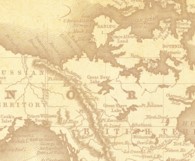
Beginning in the 1850s, the United States took its first, incautious steps toward developing an overseas empire in the Pacific. In the end, the empire would help defeat Japan during World War II.
The bloodiest and most infamous battles of the Pacific War were fought on possessions gained by American imperialists. The first American shots of the war were fired at Pearl Harbor; the first major invasion of American territory happened in the Philippines; the first major U.S. victory occurred at Midway; and Samoa was a linchpin in the allied communication line, running from Midway to Fiji to continue supplying U.S. forces in Australia. To American strategic thinkers, the islands were the advanced bases that kept Americans from fighting in the Pacific rather than on the west coast. Many died – both American and Japanese – to attack or defend America’s possessions.
While the 1940s may have demonstrated the strategic value of the Pacific, it was not apparent in the eyes of its architects almost a century before. Throughout most of the nineteenth century, few traveled to the islands and those who did were not imaginative enough to foresee World War II. To nineteenth century eyes, the islands were nearly worthless to the U.S. military and negligible for its economy.
Yet, the empire grew every decade. The first territories were annexed in the 1850s and 1860s, and included places like Midway. By the 1870s, American citizens were effectively running the Hawaiian government, steering the course toward annexation. And by the 1880s, the U.S. government was directly administering Samoa and behaving like a traditional imperial power in cooperation with the British and German governments. The United States was already administering an empire across thousands of miles of ocean by the Spanish-American War.
The Price of Empire asks why the United States developed an empire in the Pacific so early in its history? The conventional wisdom among many historians is that there were forces within the continental United States that yearned to expand. U.S. manufacturers and farmers sought markets for American products or a route to China; churches wanted to bring Christianity to the Pacific islanders; and the Navy needed advanced outposts for future wars. These views emphasize how these powerful forces of expansion organized themselves and pressured expansionists in the White House and in the Senate. International Relations scholars, while using different language concur with this view, making the United States an example of broader themes.
This book presents a different view about the origins of America’s Pacific Empire. It makes two central arguments. The first argument is that Americans were interested in the islands themselves. The conventional wisdom usually holds that Americans were not interested in islands in and of themselves; they were connections to some grander purpose. They were ports on the path to power, trade, or evangelism. On this view, they are not interesting because they were only indirect objects of American attention. The prize was on the other side of the ocean.
The Price of Empire shows that the islands and their politics were a central concern of American entrepreneurs and many government officials. The U.S. government nearly sparked conflicts with Germany and Peru over the islands, sent sailors to fight indigenous governments, and haggled with great statesmen like Bismarck in order to secure American interests.
The origins of American imperialism relate to the small entrepreneur and her role in American society. American entrepreneurs were the key players in the creation of the empire. They went abroad because of their economic interests. The nineteenth century was a time of dynamic commodity prices; there were booms and busts of commodities like cotton, rubber, and sugar. This boom-and-bust cycle generated brief periods in which there were incredibly lucrative incentives for individuals to go abroad in search of commodities.
When there was a commodity boom, entrepreneurs raced into Pacific islands to set up shop, creating farms and plantations or staking claims for mining. These entrepreneurs created the first sustained U.S. interests in the islands. They also became a loud lobby for American expansion. When their profits were threatened, usually by foreign competitors who followed them to the islands or a decline in prices, they demanded that the United States come to their rescue. They lobbied the government, manipulated the press, agitated in the Churches, and lied on Capitol Hill to get the United States to formally acquire the islands. It was these economic interests, tied to small American enterprises abroad, that dragged the United States into early imperialism.
This is illustrated in the following figure. In Samoa, American imperialists followed rising copra prices (dried coconut husks). The primary American planter, H.J. Moors, arrives in a period of growing prices, creating the first American plantation on the islands. Competition with Germany, during a period of price decline, sees him travel to Washington, demanding that the United States seize the islands.
In sum, small American economic interests drove its early imperial policy. No grand interests were at stake. It was entrepreneurs who fought to secure their investments, slave owners who worried foreign competitors might lure away their slaves, grifters wanting protection from other governments when looking to mine a mountain of guano on a deserted island, or sugar planters who worried an indigenous government would reduce their influence within the kingdom.
The structure of the American economy and state permitted them a level of influence that might surprise us today. In the nineteenth century world, when travel was uncommon and explorers were heroes, these entrepreneurs had an outsized influence owing to their supposed knowledge of world affairs and experience with the “savages.” They traded on this influence to encourage imperialism decades before the Spanish-American War, creating the first Pacific Empire.
Latest Comments
Have your say!